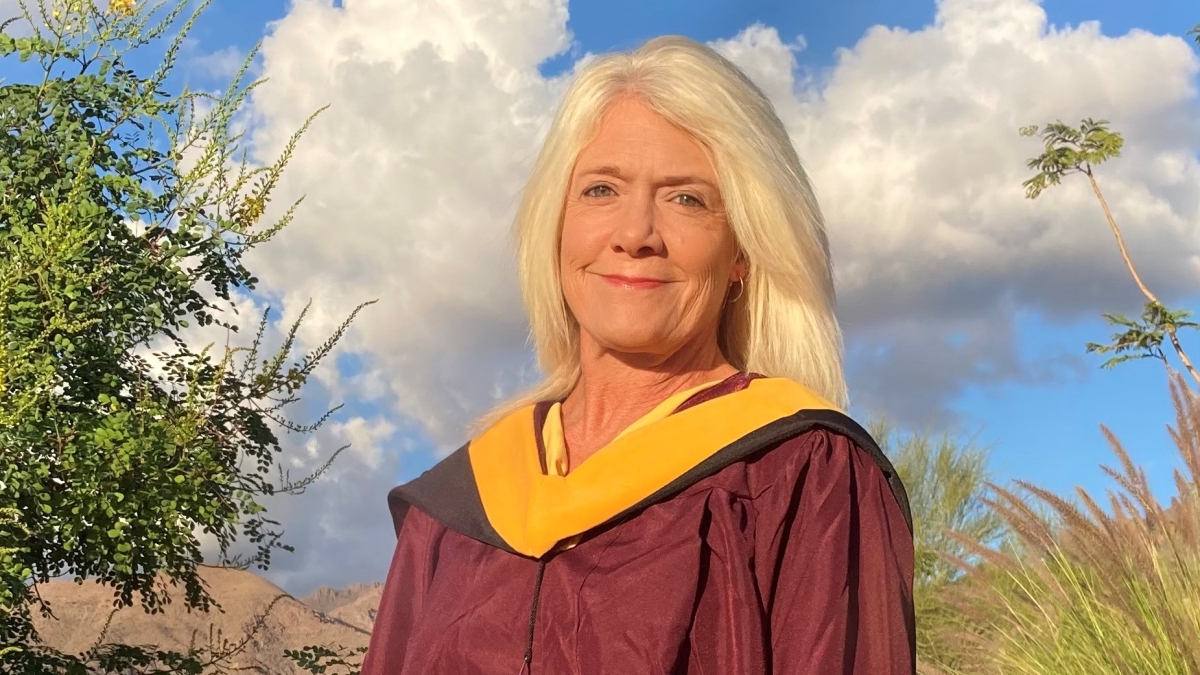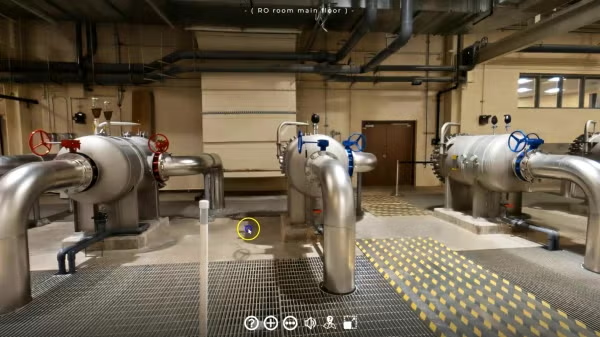Drawing inspiration — and solutions — from nature

Robin Berry, the School of Complex Adaptive Systems' fall 2023 Outstanding Graduate, is graduating with a Master of Science in biomimicry. She said that moving to the Sonoran Desert cemented her interest in replicating one of nature’s greatest skills: resilience. Photo courtesy of Robin Berry
Editor’s note: This story is part of a series of profiles of notable fall 2023 graduates.
To find examples of adaptation, ingenuity and survival against the odds, Robin Berry turns to the outdoors.
She grew up on the East Coast, where rain and humidity created such picturesque landscapes that it looked almost impossible for the flora and fauna not to thrive. But upon moving to Gold Canyon in Arizona, she found herself entranced by the plant life that confidently grew from — and at first glance, in spite of — the dry and unforgiving climate.
Berry, the School of Complex Adaptive Systems' fall 2023 Outstanding Graduate, is graduating with a Master of Science in biomimicry. She said that moving to the Sonoran Desert cemented her interest in replicating one of nature’s greatest skills: resilience.
“When I moved to Arizona, I wanted to learn from the native plants and their mechanisms of survival,” Berry said. “If saguaro cacti can gather enough resources to grow as tall as trees, weighing thousands of pounds and functioning as natural water towers in the middle of a desert, how can we do the same?”
This question led her to the School of Complex Adaptive Systems (SCAS), a unit within the College of Global Futures at the Julie Ann Wrigley Global Futures Laboratory. Berry was already working with EdPlus at Arizona State University, so she utilized ASU’s tuition reduction program when registering for classes. While the discount was a contributing factor to her studying at ASU, it was not the main reason: ASU’s continued investment in and support for biomimicry initiatives was encouraging, and SCAS offered access to a robust team of biomimicry experts throughout the Global Futures Laboratory.
After graduation, Berry will continue to work at ASU and the Biomimicry Center, a research center within the Global Futures Laboratory, in the hopes of building the first accelerator/incubator dedicated to bio-inspired technology and innovation.
The following Q&A has been edited for clarity/length.
Question: What was your “aha” moment when you realized you wanted to study the field you majored in?
Answer: Moving to the Sonoran Desert of Arizona gave me an entirely new understanding and appreciation for the adaptability and resilience of living things. On the East Coast, trees and plants are often taken for granted. Humidity and frequent rains give the illusion of water abundance. In the desert, evidence of climate change and the impact of drought is more tangible. Perhaps the answers to human problems are right in front of us. The idea of looking to nature for solutions — which is what biomimicry entails — makes perfect sense.
Q: What’s something you learned while at ASU — in the classroom or otherwise — that surprised you or changed your perspective?
A: The act of copying, or imitating nature, is an ancient human behavior. As with RNA and DNA, the replication of life, in a chemical/biological sense but also as a creative force, is a part of our evolutionary history. Everything we need human technology to do, from growing food to powering our machines, to protecting our bodies and passing on our data, is accomplished functionally by every other living thing. The most impressive technologies, such as photosynthesis and self-healing immune systems, are examples of what AI wants to accomplish, but has not yet.
Q: Why did you choose ASU?
A: I work here, and I live here. I should learn here. And with what I learn, I can put something back into this community, which is the goal.
Q: Are there any professors you would like to call out specifically who taught you an important lesson while at ASU?
A: Mark Dorfman, a faculty member in SCAS and a senior Global Futures scientist. He taught chemistry and summarized chemical mechanisms in a profound but succinct way: shape complementarity and molecular recognition, with selective reactivity. Custom keys that fit into only the right locks. Nature’s puzzle pieces that self-assemble based on simple rules, like charge, position, attraction, weak intermolecular forces, etc. All with zero negative impacts to life. These are the types of elegant solutions we need.
Q: What’s the best piece of advice you’d give to those still in school?
A: Learning is not linear, and academics alone aren’t enough. To make things happen takes an interactive ping-pong match of school and life experiences. Seek out both.
Q: What was your favorite spot for studying, meeting friends or just thinking about life?
A: I’m a student of applied biology, but I think anyone that designs creatively, architecturally or as an engineer can draw inspiration from nature. So I recommend the arboretums and botanical gardens in and around the Phoenix metro area. Boyce Thompson Arboretum is my favorite.
Q: You plan to continue to work with the Biomimicry Center after graduation to build the first accelerator/incubator dedicated to bio-inspired technology and innovation. If someone wants to get involved or is interested in your work, how can they contact you?
A: Anyone who is interested in this is welcome to contact me via email at Robin.L.Berry@asu.edu.
Q: If someone gave you $40 million to solve one problem on our planet, what would you tackle?
A: The goal is to raise that $40 million for our incubator, to support and apply innovative ideas coming out of ASU for bio- and nature-inspired solutions to human challenges. As one of the country’s leading public research universities, we need this. And we are capable of achieving it.
More Environment and sustainability

2 ASU faculty elected as AAAS Fellows
Two outstanding Arizona State University faculty spanning the physical sciences, psychological sciences and science policy have…

Homes for songbirds: Protecting Lucy’s warblers in the urban desert
Each spring, tiny Lucy’s warblers, with their soft gray plumage and rusty crown, return to the Arizona desert, flitting through…

Public education project brings new water recycling process to life
A new virtual reality project developed by an interdisciplinary team at Arizona State University has earned the 2025…

